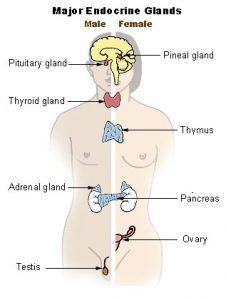Endocrine System Fun Facts
The endocrine system is made up of a series of organs within the body, including the brain, pancreas, ovaries, testicles, and thyroid gland. These organs secrete hormones into the blood stream to regulate many of the body’s functions. Many of these glands help to regulate each other, such as by the pituitary gland secreting thyroid stimulating hormone, also known as TSH. This stimulates the thyroid gland to produce a hormone called thyroxine. Diseases can affect one gland or multiple within the body.
Some of the major parts of the endocrine system are outlined on the illustration below.

Top 20 Fun Facts
- Endocrinology, the study of the endocrine system, has been studied for thousands of years. There is evidence of Chinese healers studying these body systems and learning to extract hormones from urine to use for medical purposes.
- Even though endocrinology has been studied for millennia, the term hormone has only been used since the early 1900s.
- Osteoporosis is a disorder where the bones of the body become less dense and more brittle. It can be caused by endocrine disorders, such as hyperthyroidism.
- The hypothalamus produces hormones that help to regulate how hungry or thirsty you are.
- In diabetes mellitus, the body’s blood sugar levels are not well regulated, generally causing too much blood sugar or glucose to circulate. The excess is excreted in the urine. Prior to modern diagnostics, physicians would taste urine to determine if it was sweet to diagnose a person with diabetes.
- The body makes almost 30 different hormones. These are largely the same between different mammalian species.
- The endocrine glands are all ductless. They secrete hormones straight into the blood stream.
- The pituitary gland has three lobes. They are the posterior, the intermediate, and the anterior lobes.
- The pituitary gland is roughly the shape and size of a pea, which is impressive as it is the most important gland in the body. It regulates the other endocrine glands.
- The pineal gland is located in the brain and has a shape similar to that of a pine cone.
- The thyroid gland is shaped similar to a butterfly and is located in the lower part of the neck.
- The thyroid gland has both a right lobe and a left lobe. They are connected by an isthmus.
- Iodine is essential for the thyroid gland to function. People and animals with a deficiency may develop a goiter. To help prevent iodine deficiency, companies make iodized salt.
- There are 4 parathyroid glands. These smaller glands are located in the thyroid gland.
- The pancreas has digestive functions, as well as endocrine functions. The endocrine portion releases insulin and glucagon for blood sugar regulation.
- The adrenal glands are located above each kidney. A pheochromocytoma is a tumor that can occur within them.
- The adrenal glands help to maintain the balance of water and salt within the body. They also help respond to stress.
- Testosterone is a sex hormone secreted by the testes. It causes secondary changes such as enlargement of the voice box, which causes the voice to be deeper.
- Progesterone is a sex hormone secreted by the ovaries. It helps regulate a female’s menstrual cycle.
- Other organs can perform endocrine functions and release hormones even though they aren’t considered part of the endocrine system. These organs include the stomach, placenta, liver, and kidneys.